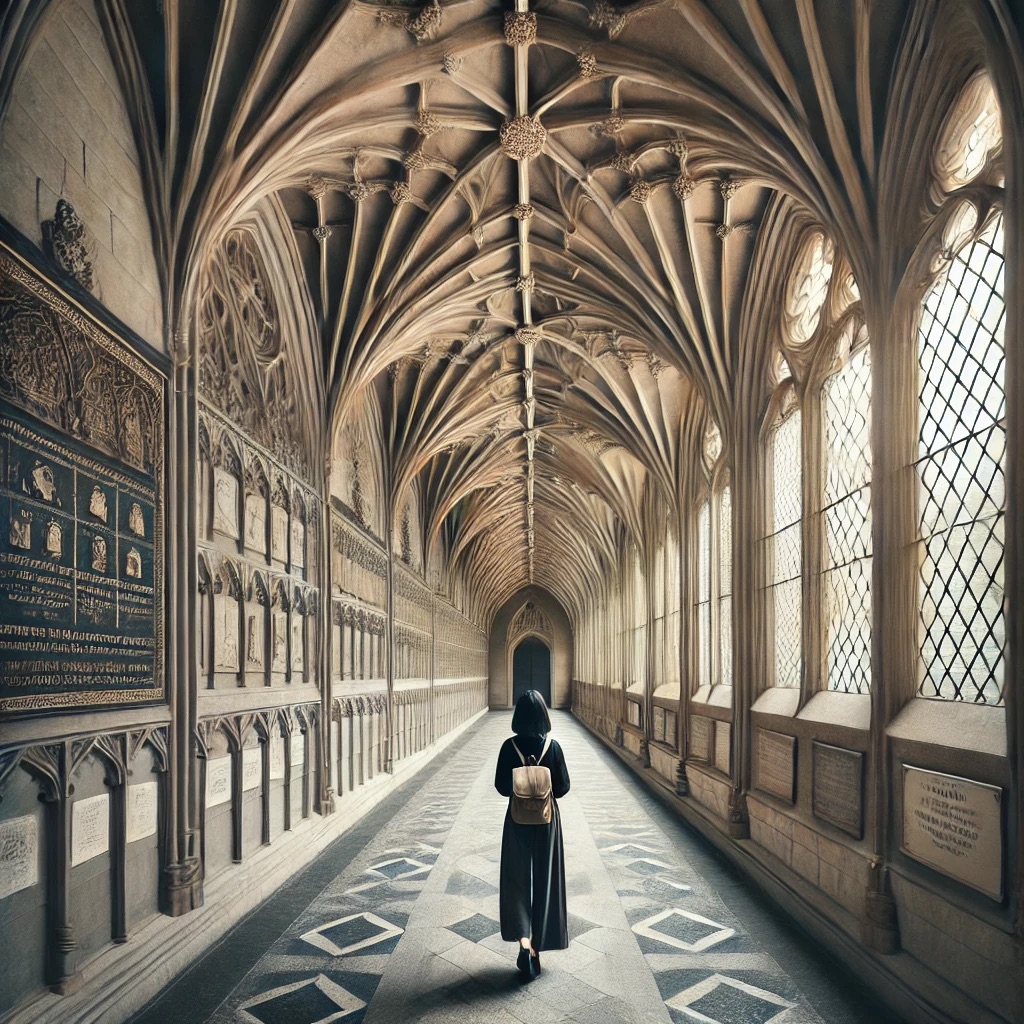ChatGPT:
Wells is a charming small city located in Somerset, England. Despite its small size, it holds the distinction of being the smallest city in England, due to its cathedral, Wells Cathedral, which dates back to the 12th century. The city is named after three wells dedicated to Saint Andrew, with one located in the grounds of the Bishop’s Palace and the other two within the city center.
Wells is known for its stunning medieval architecture, particularly the Wells Cathedral, which is renowned for its grand façade, intricate Gothic architecture, and the unique “scissor arches” inside. Adjacent to the cathedral is the Bishop’s Palace, a moated residence surrounded by beautiful gardens, which has been the home of the Bishops of Bath and Wells for over 800 years.
The city’s market square is another focal point, hosting a twice-weekly market where local produce, crafts, and goods are sold. The square and surrounding streets are lined with historical buildings, quaint shops, and cafes, making it a pleasant place for a stroll.
Wells has also been a popular filming location, notably for the movie Hot Fuzz. The city’s blend of historical charm and vibrant community life, combined with its picturesque setting near the Mendip Hills, makes it a popular destination for visitors seeking to explore English history and culture in a serene environment.
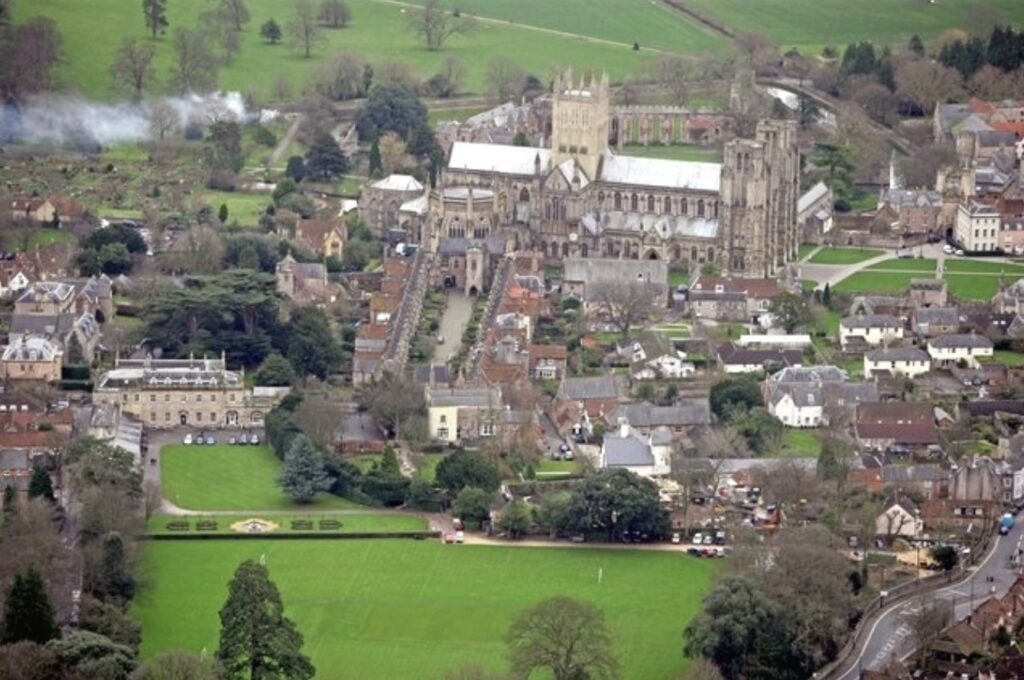
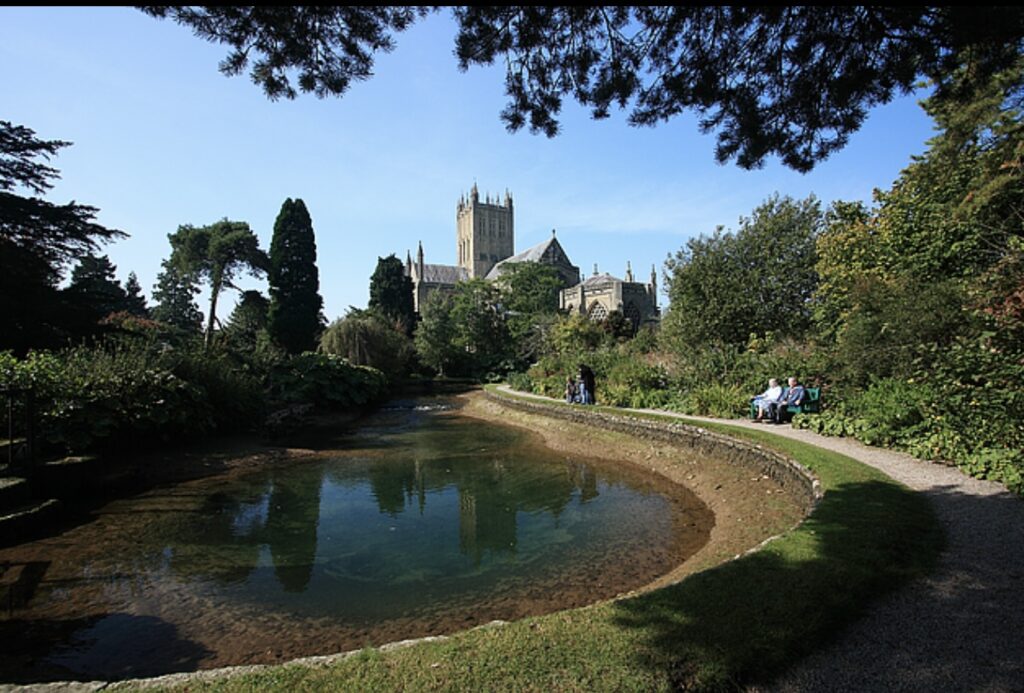
Wells has a rich history that dates back to the Roman period and possibly earlier. The city’s name derives from the natural springs, or wells, that have been a significant part of the area’s history, particularly those associated with Saint Andrew.
Early Origins
The site where Wells stands has been occupied since Roman times, with evidence of Roman buildings and occupation found in the area. However, Wells truly began to develop as a religious site in the early medieval period. The first documented evidence of a settlement at Wells dates back to around 704 AD, when King Ine of Wessex founded a minster church dedicated to Saint Andrew. This church was built near the wells that gave the city its name and marked the beginning of Wells’ development as an important religious center.
Medieval Development
In 909 AD, Wells became the seat of the new bishopric for Somerset, elevating its status and leading to the construction of a cathedral. However, this status was short-lived, as the bishopric moved to Bath in 1090. Despite this, Wells remained significant, particularly when Bishop Robert of Lewes, in the 12th century, began the construction of the current Wells Cathedral. The cathedral was a major project and became one of the most beautiful and architecturally significant cathedrals in England, known for its Early English Gothic style.
During the medieval period, Wells grew around the cathedral and the Bishop’s Palace, the residence of the bishops of Bath and Wells. The town’s layout, with its narrow streets and medieval buildings, largely reflects this period of development.
Growth as a Market Town
Wells also developed as a market town during the Middle Ages, with its market charter granted in 1201 by Bishop Reginald Fitz Jocelin. The market, still held today, became central to the town’s economy, fostering trade and commerce in the area.
The town’s status as a city was confirmed by its cathedral, despite its small population. This distinction of being the smallest city in England has persisted through the centuries, largely due to its religious significance.
Post-Medieval Period
In the post-medieval period, Wells continued to be a religious and administrative center, though its growth slowed compared to larger cities. The English Civil War in the 17th century affected Wells, with the city seeing some military action, but it largely retained its medieval character.
During the 18th and 19th centuries, Wells saw modest growth and development, with improvements to its infrastructure, including the building of new roads and the arrival of the railway in the 19th century, which connected it more effectively with the rest of Somerset and beyond.
Modern Era
In the 20th and 21st centuries, Wells has remained a small but culturally significant city. It has become a popular tourist destination, known for its well-preserved medieval architecture, especially the cathedral and the Bishop’s Palace. The city’s character and heritage have been carefully maintained, with many of its buildings listed as historically significant.
Today, Wells is a blend of its historic past and modern amenities, continuing to attract visitors for its unique charm and historical significance. Its role as a religious center remains important, with the Wells Cathedral still active as the seat of the Bishop of Bath and Wells.
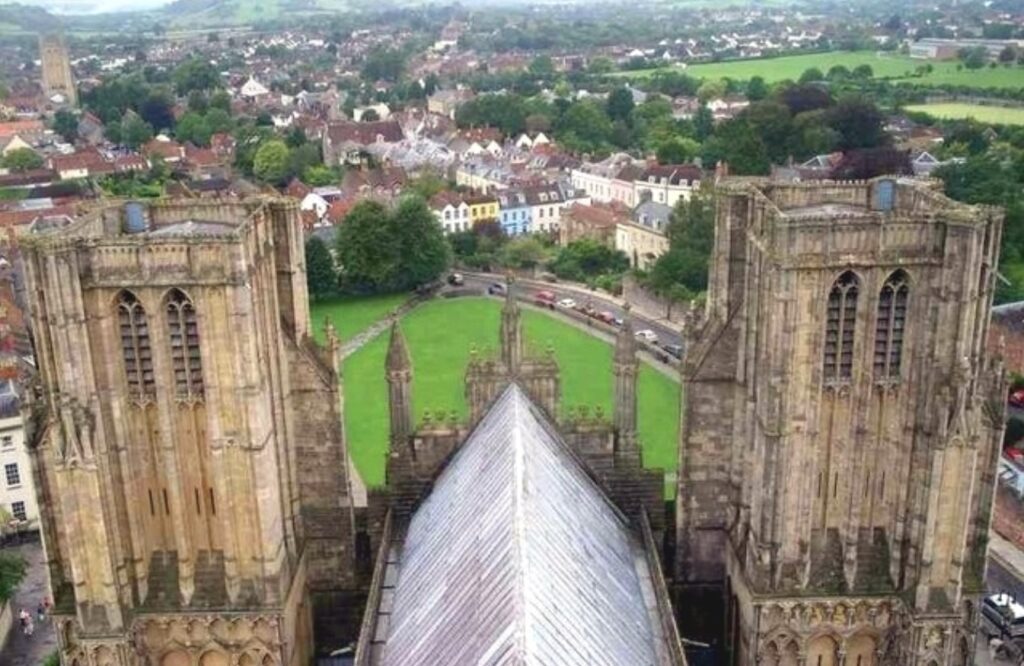
Wells Cathedral
Wells Cathedral is renowned for its Early English Gothic architecture, a style that emerged in England in the late 12th century. The cathedral is one of the first major examples of this style, characterized by its pointed arches, ribbed vaults, and flying buttresses, which were innovations that allowed for larger windows and more light-filled interiors.
Key Architectural Features:
- West Front: The most iconic feature of Wells Cathedral is its magnificent West Front, completed around 1250. The façade is a vast stone screen adorned with nearly 300 statues and carvings, many of which are life-sized or larger. These sculptures depict biblical scenes, saints, and kings, serving as a visual representation of the Christian faith. The symmetry and intricate detail of the West Front make it one of the most remarkable examples of medieval stonework in England.
- Scissor Arches: Inside the cathedral, the unique “scissor arches” are a standout feature. These are a form of arch created in the 14th century by master mason William Joy to stabilize the central tower, which was sinking under its own weight. The scissor arches are two intersecting pointed arches that create a dramatic and distinctive effect, both functional and aesthetically impressive.
- Chapter House: The octagonal Chapter House, built in the early 14th century, is another architectural highlight. It is reached by a wide, winding staircase known as the “Chain Bridge” steps, which have been worn down over the centuries by countless feet. The Chapter House is notable for its ribbed vaulting and the central pillar, which branches out like the trunk of a palm tree, supporting the ceiling.
- The Nave: The cathedral’s nave is spacious and light-filled, characterized by its tall, slender columns and pointed arches. The clerestory windows flood the space with light, emphasizing the verticality typical of Gothic architecture.
- Stained Glass: Wells Cathedral contains some of the finest medieval stained glass in England, particularly in the east window, known as the Jesse Window, which dates from the late 14th century. The window depicts the genealogy of Christ, starting with Jesse, the father of King David.
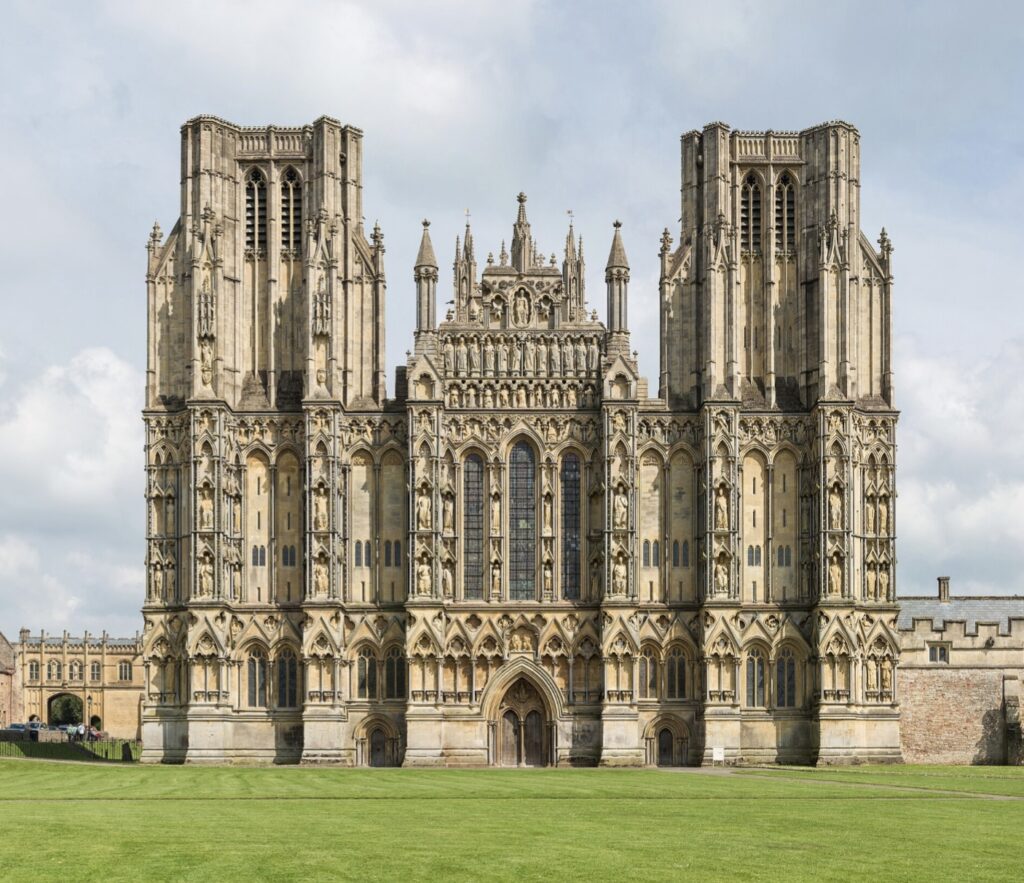
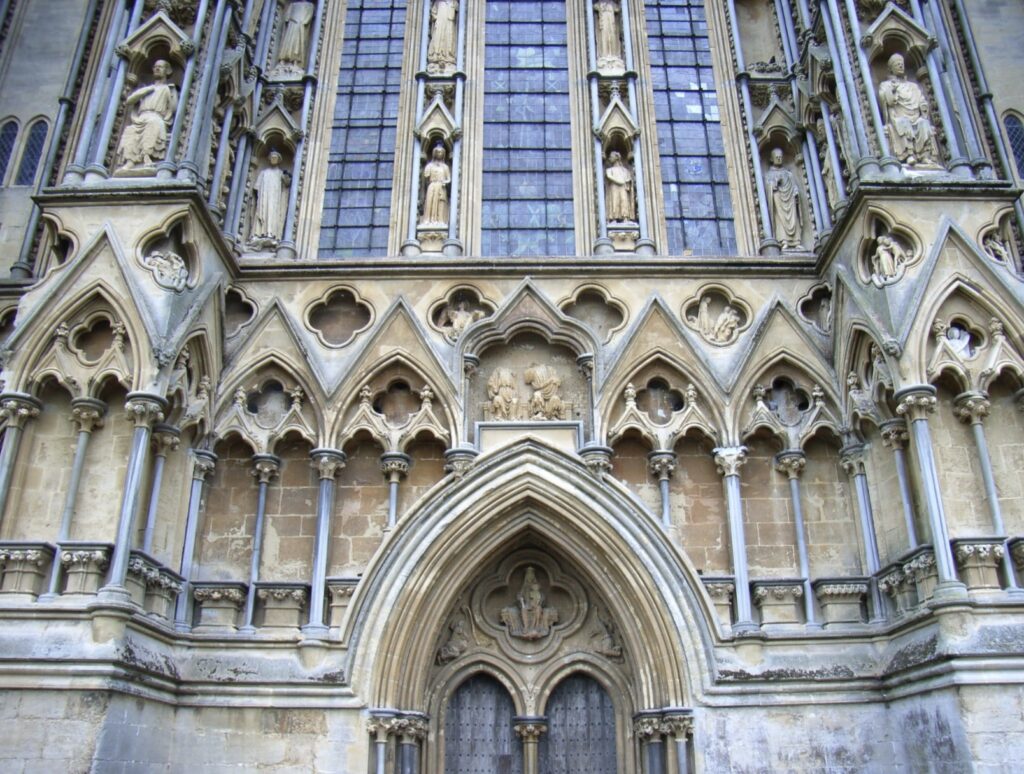
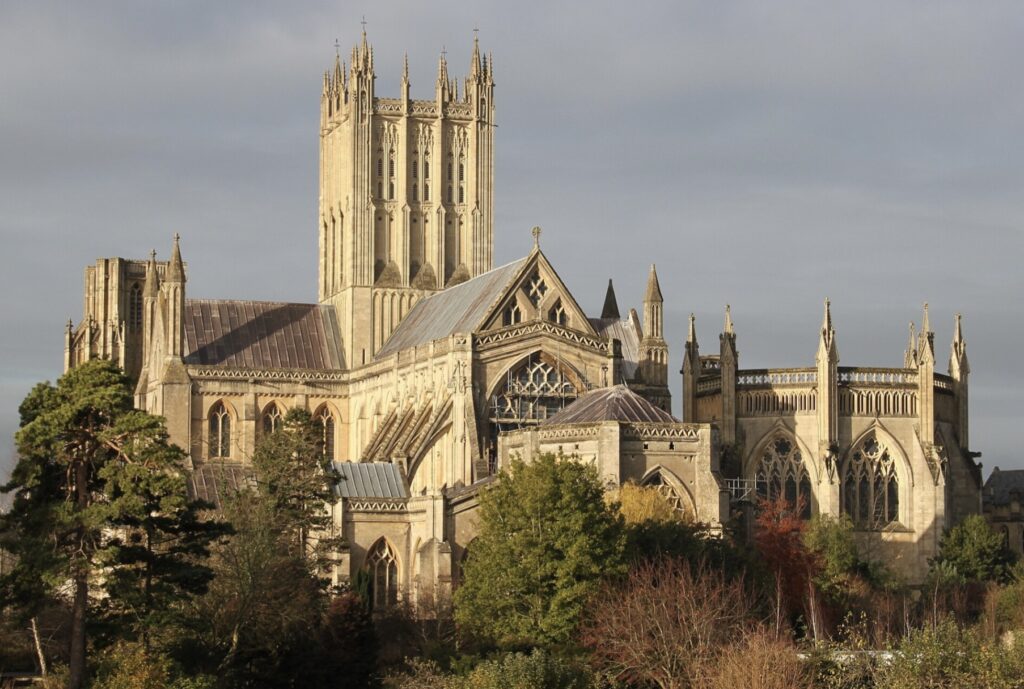
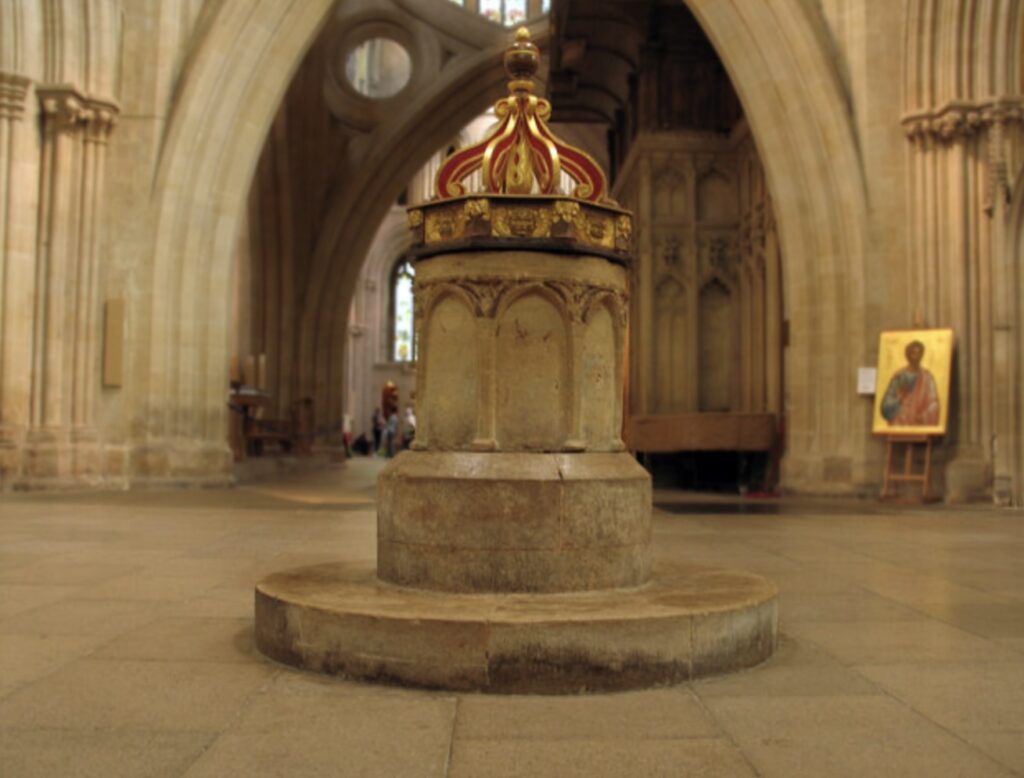
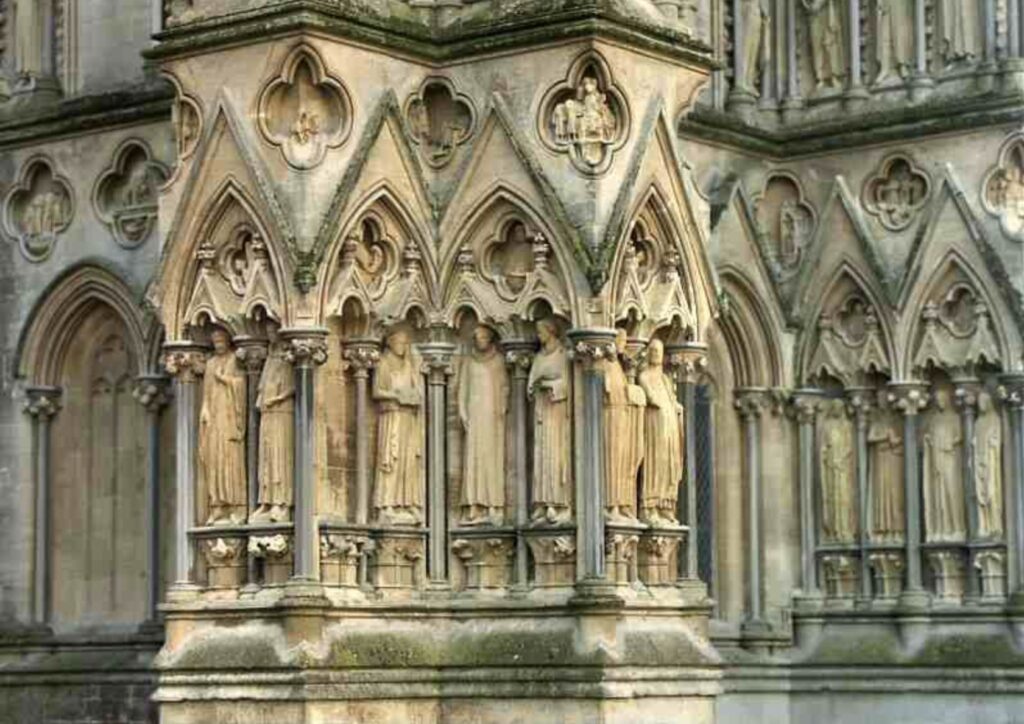
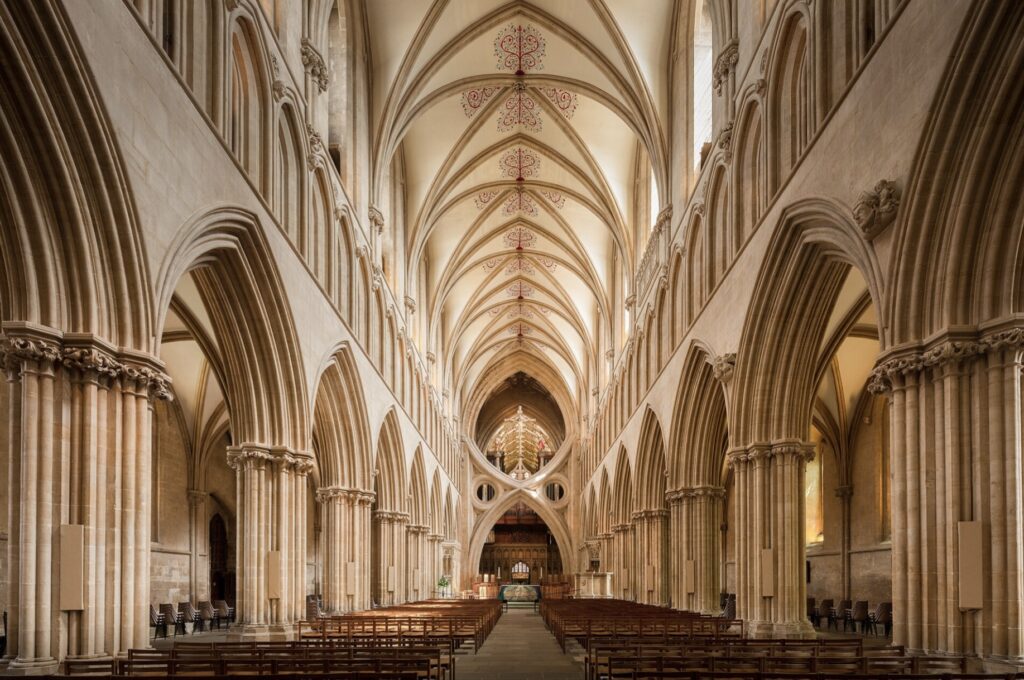
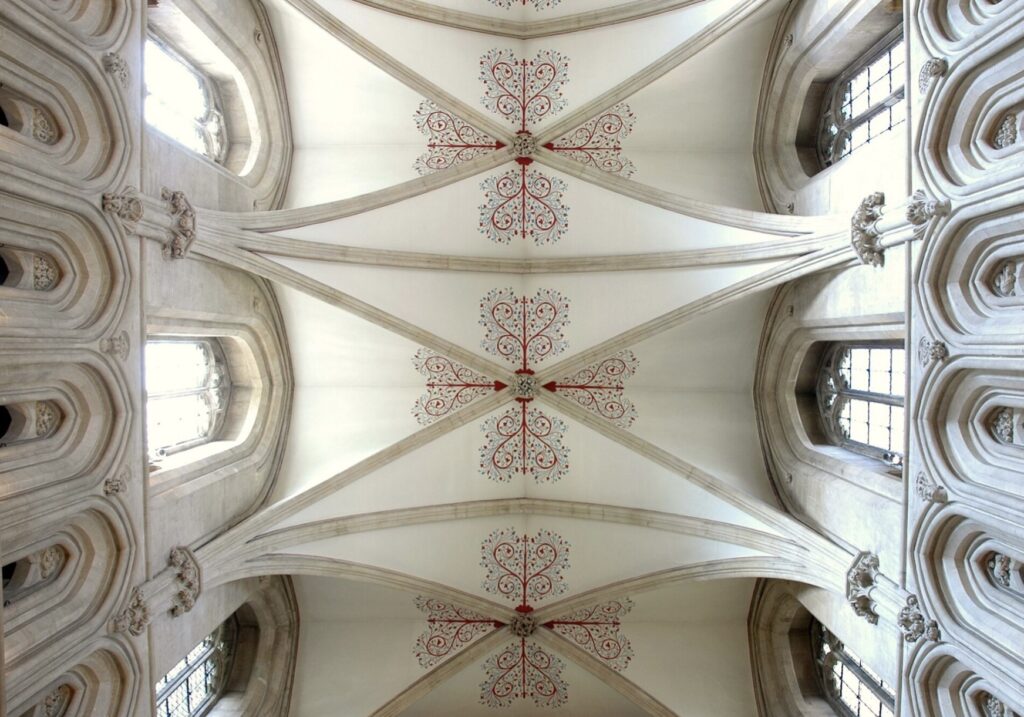
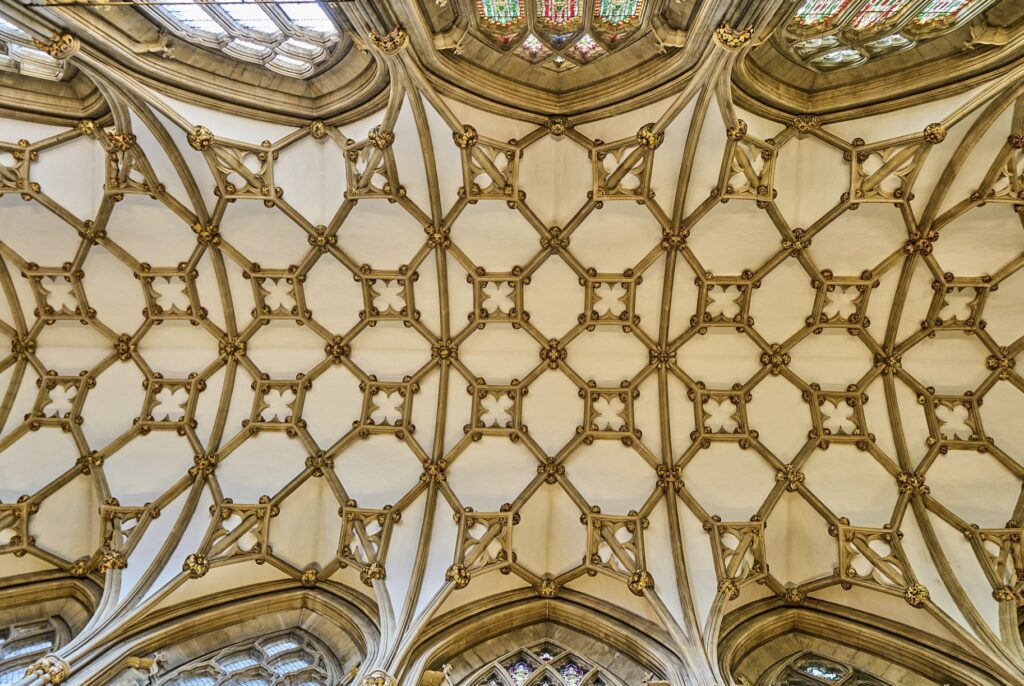
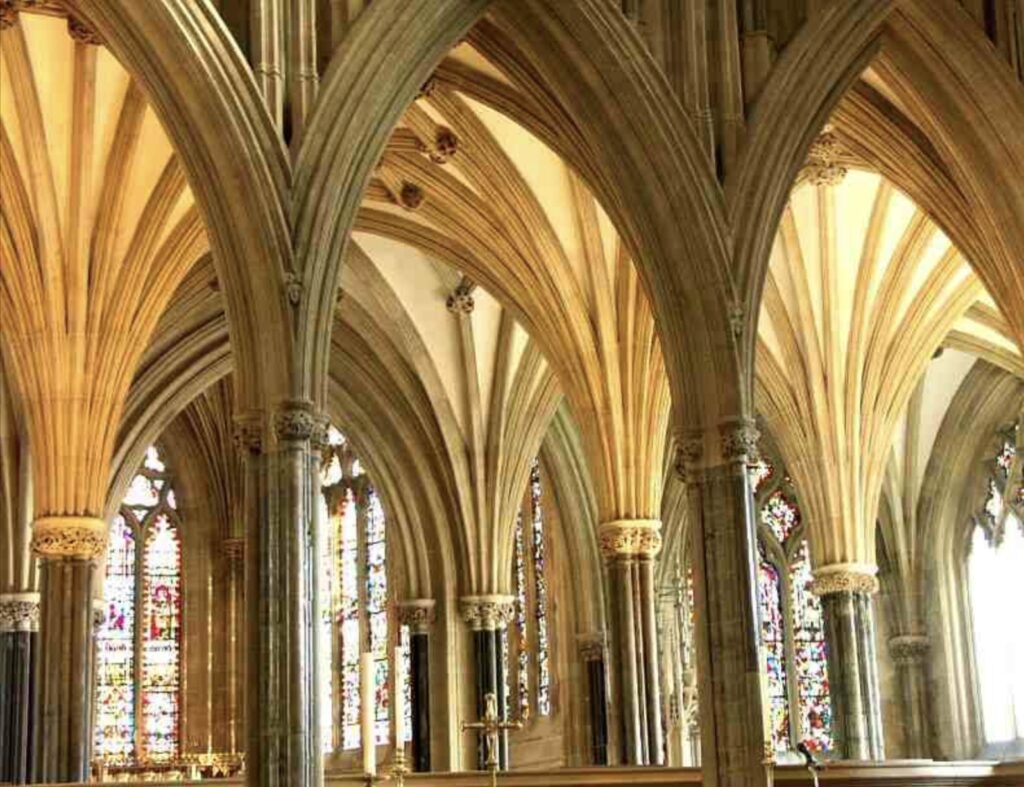
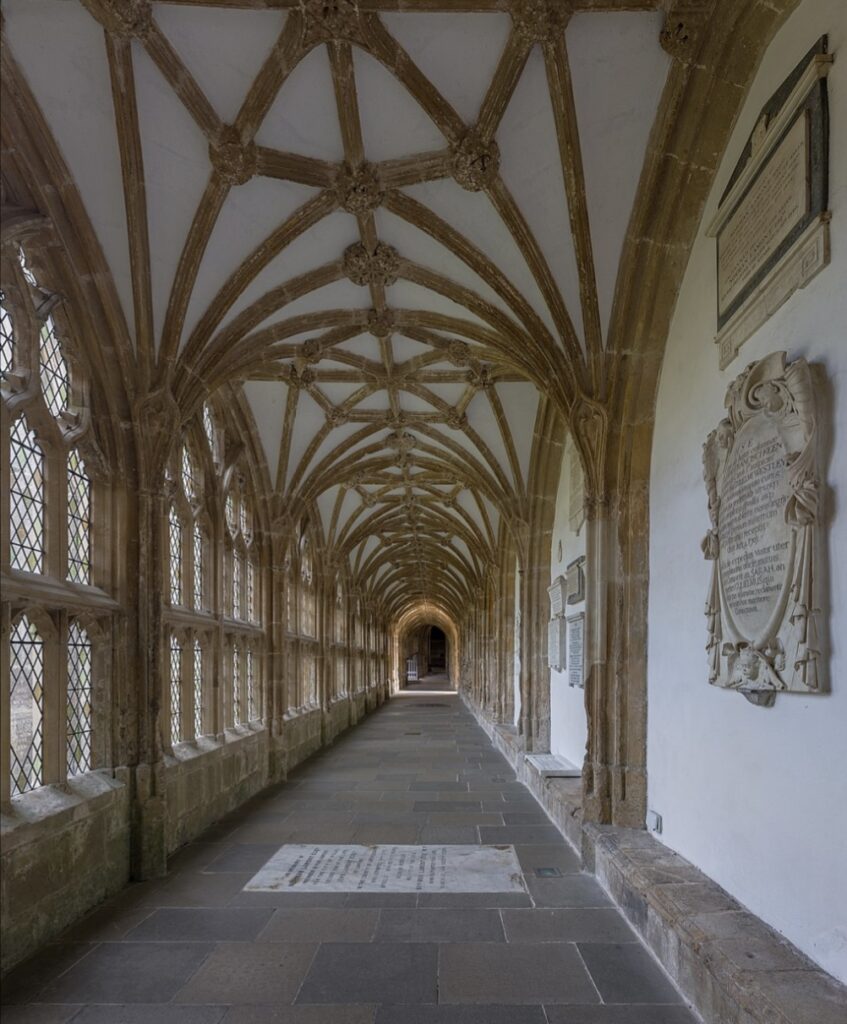
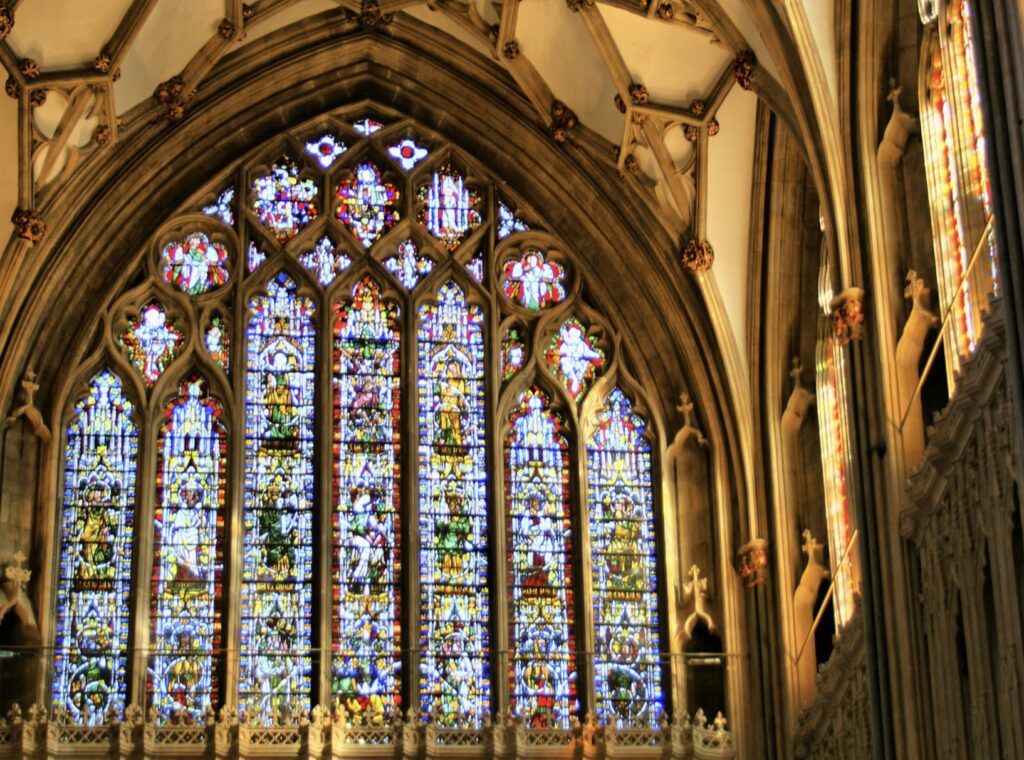
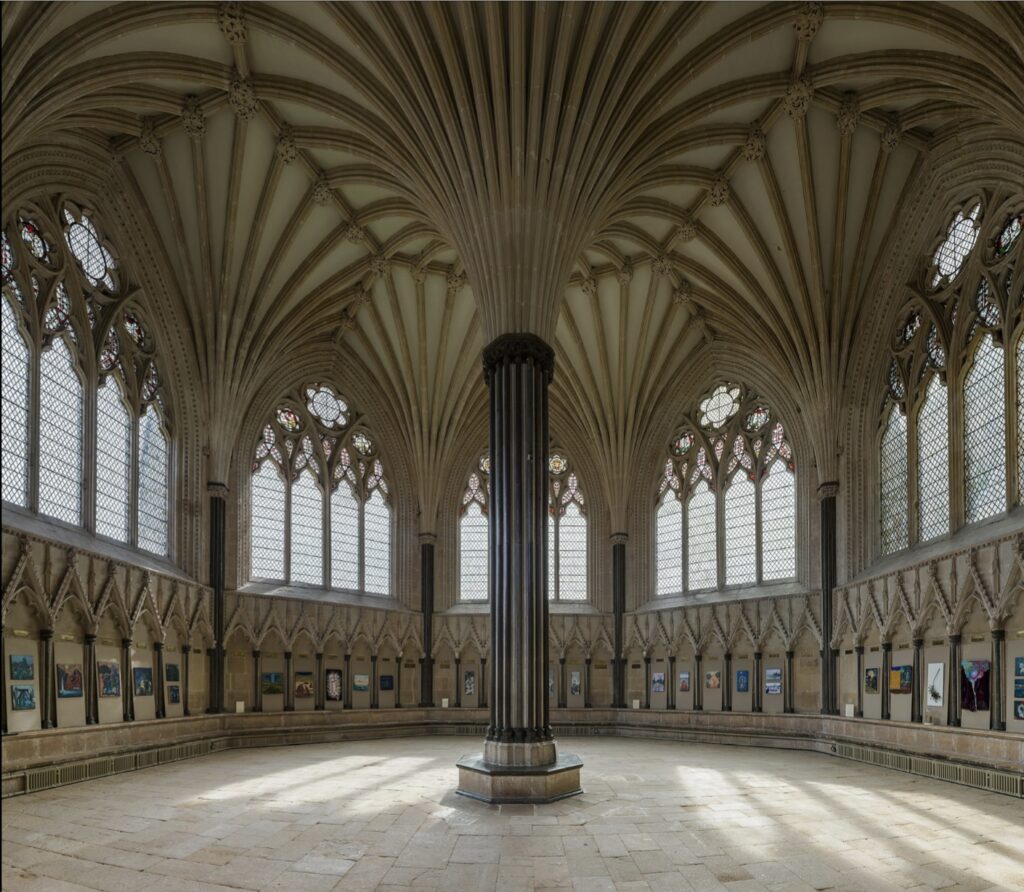
The Bishop’s Palace
The Bishop’s Palace, adjacent to Wells Cathedral, is a fortified medieval palace that has been the residence of the Bishops of Bath and Wells for over 800 years. The palace is surrounded by a moat and includes both the original medieval structures and later additions.
Key Architectural Features:
- Fortified Walls and Gatehouse: The palace is surrounded by a defensive moat, walls, and a gatehouse, which were added in the 14th century by Bishop Ralph of Shrewsbury. The moat is one of the palace’s most distinctive features, creating a picturesque setting and reflecting the building’s dual role as both a residence and a fortification.
- Great Hall: Although now partially in ruins, the Great Hall was once the heart of the palace, a large and impressive space used for feasts and gatherings. The hall’s remaining walls and large windows provide a sense of the grandeur it once possessed.
- Chapel: The Bishop’s Chapel, built in the 13th century, is a fine example of Early English Gothic architecture, mirroring the style of the cathedral. It features elegant lancet windows and a rib-vaulted ceiling.
- Undercroft: Beneath the chapel is the undercroft, a vaulted space used historically for storage. It is supported by sturdy stone pillars and has a somber, atmospheric quality.
- Gardens: The Bishop’s Palace is also famous for its gardens, which have been developed over the centuries. The gardens include formal layouts, such as the parterre garden, as well as more naturalistic settings. The wells that give the city its name can be found in these gardens, flowing into the moat.
- Residential Quarters: The residential part of the palace has been continuously adapted over the centuries, with various bishops adding their own touches. The interiors blend medieval and later architectural styles, reflecting the long history of the building’s use.
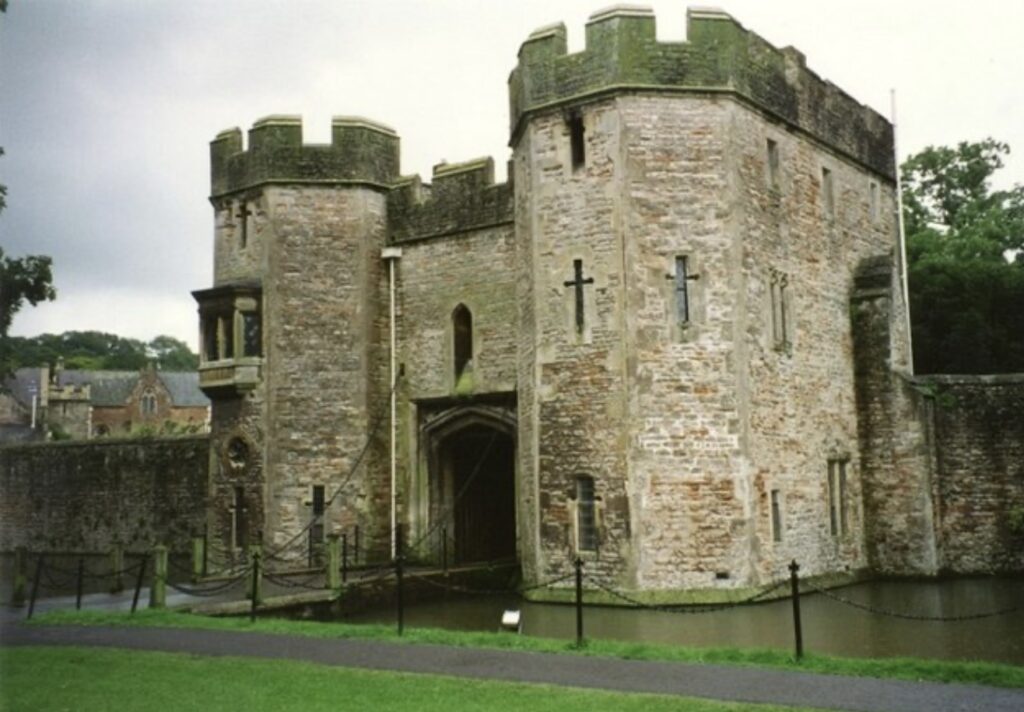
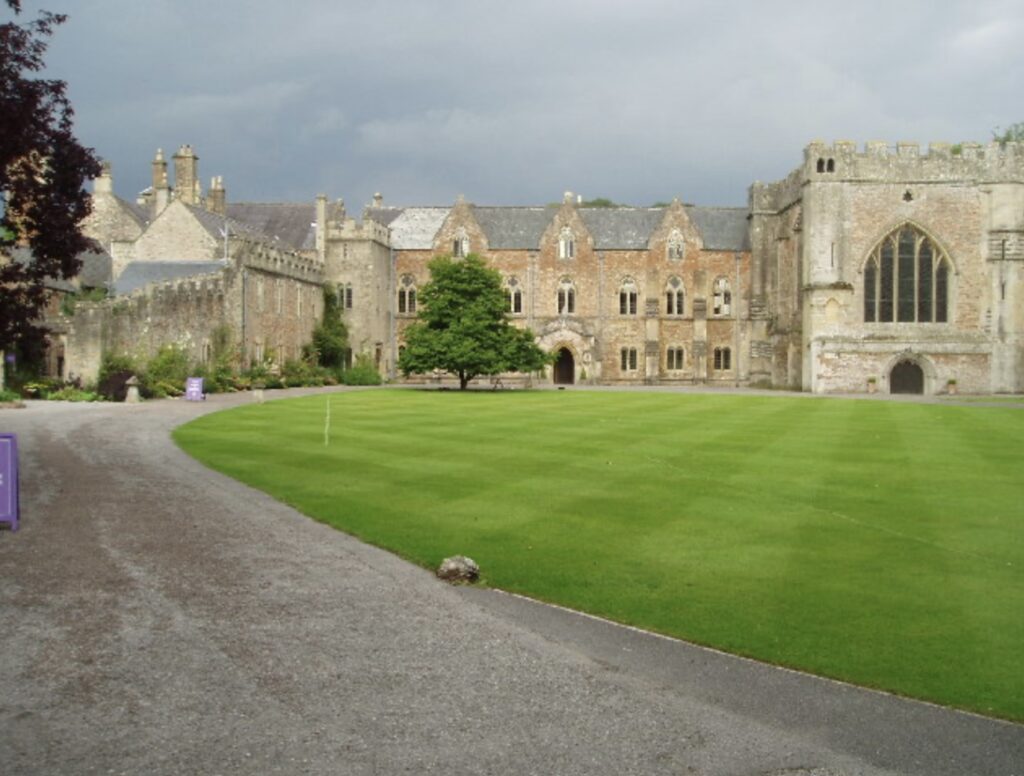
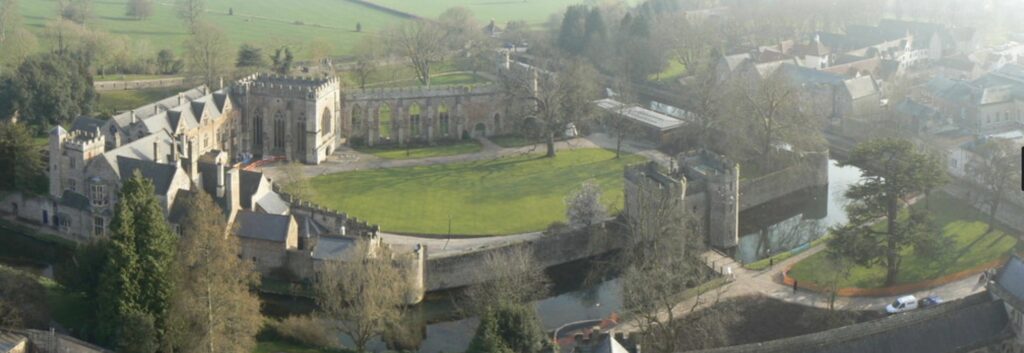
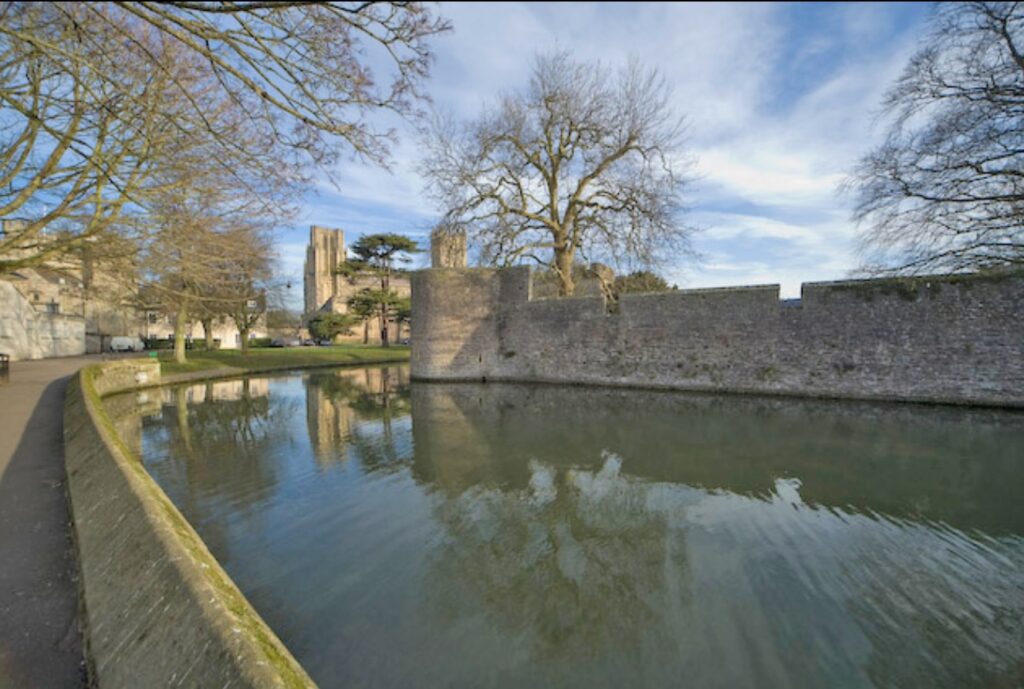
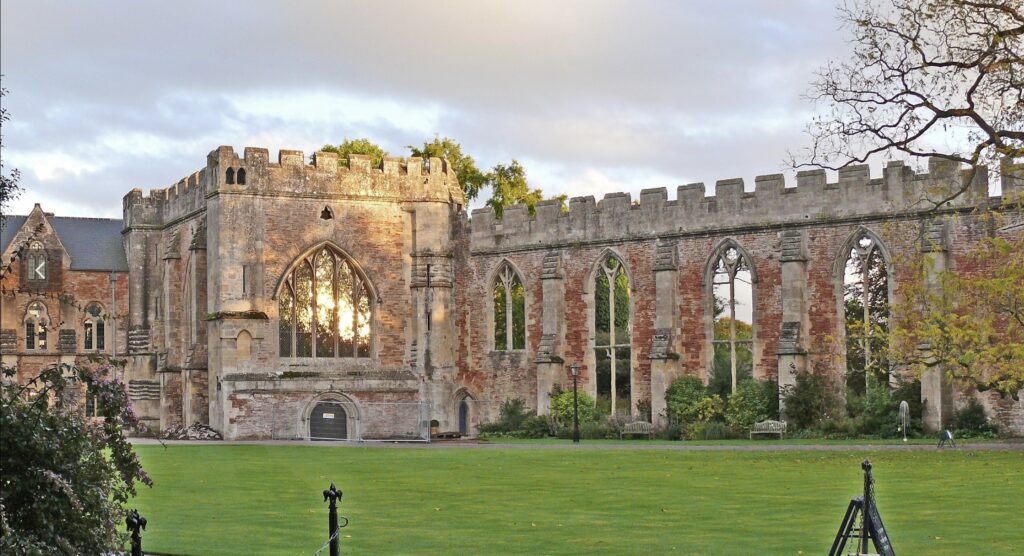
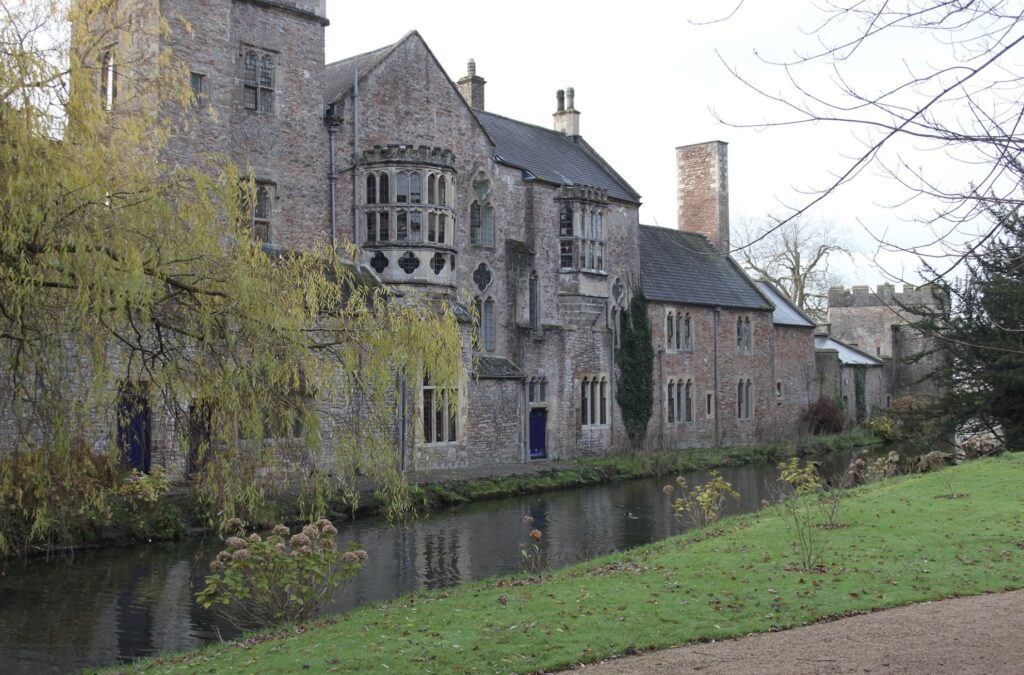
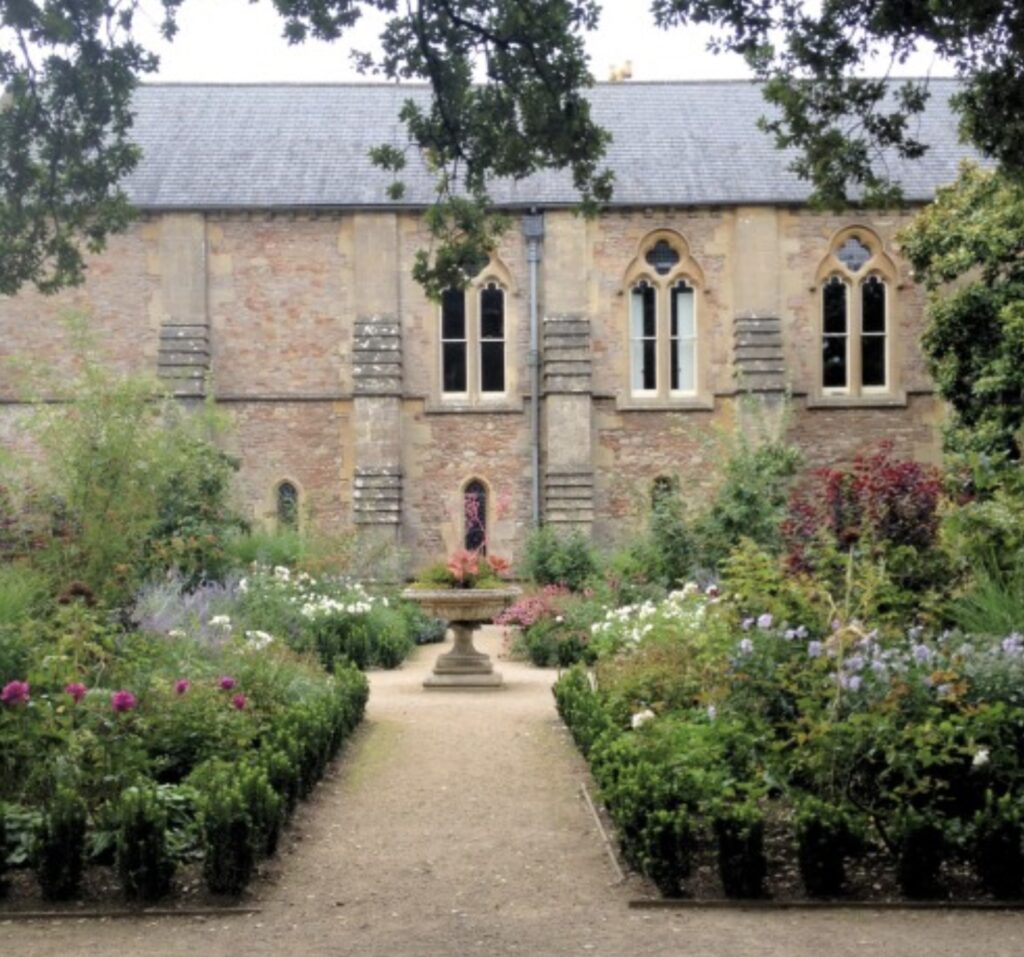
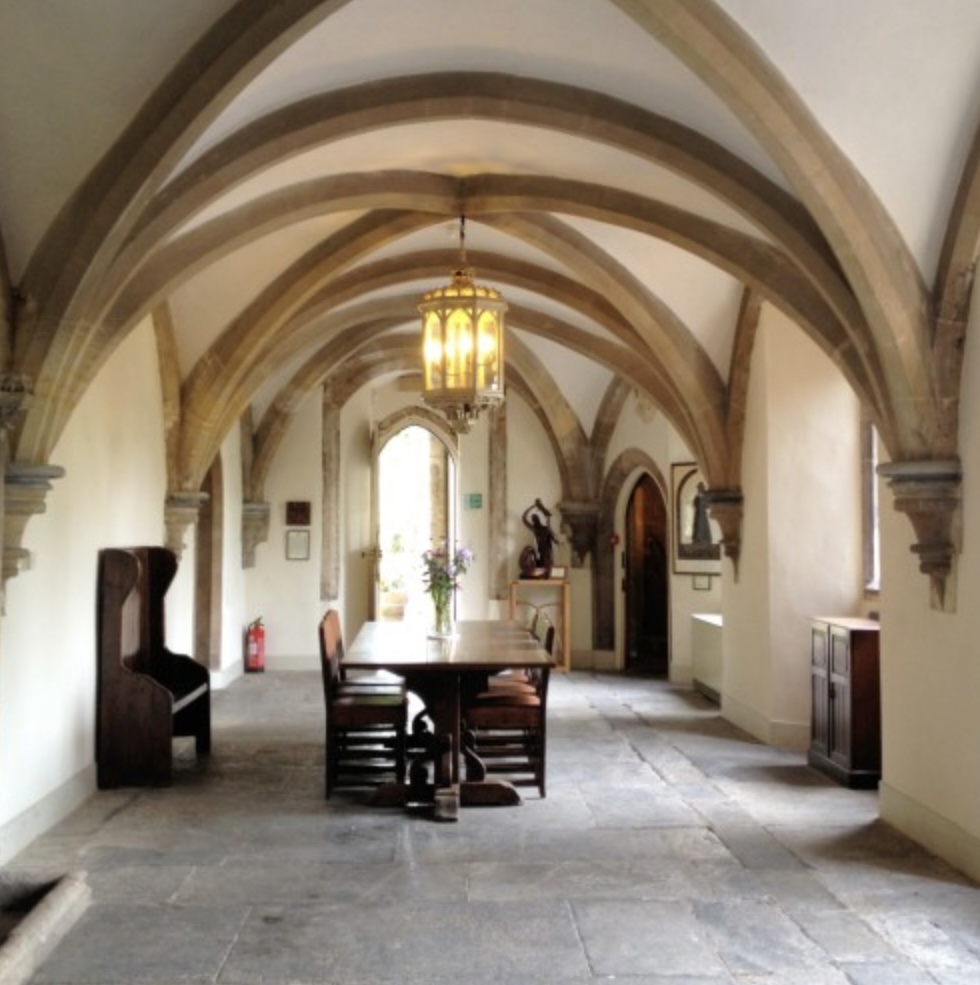
Wells, despite its small size, is rich in historical monuments and attractions that draw visitors interested in history, architecture, and the charm of English small towns. Here is a list of other key historical monuments and tourist attractions in Wells:
1.Vicars’ Close
- Description: Vicars’ Close is claimed to be the oldest continuously inhabited residential street in Europe. Built in the 14th century to house the cathedral’s vicars, it retains much of its original medieval character.
- Highlights: Uniform medieval houses, cobbled street, and the Vicars’ Hall and Library.
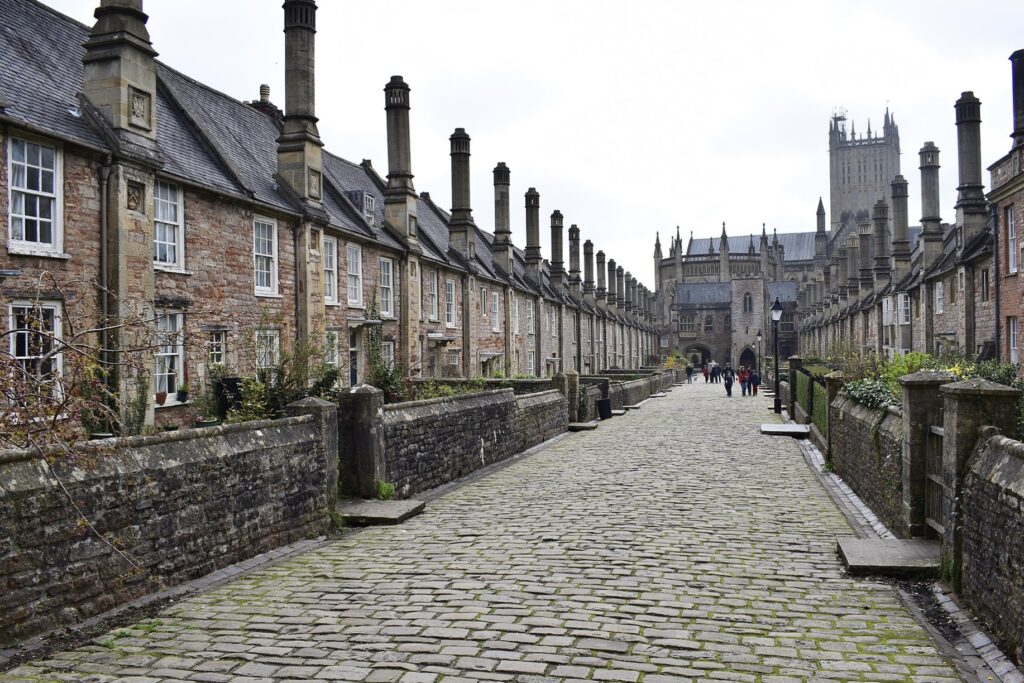
2. The Market Place
- Description: Wells’ Market Place is a central hub for the town, hosting a lively twice-weekly market with stalls offering local produce, crafts, and goods. The square is surrounded by historic buildings and provides a vibrant atmosphere.
- Highlights: Market stalls, historic buildings, and proximity to Wells Cathedral.
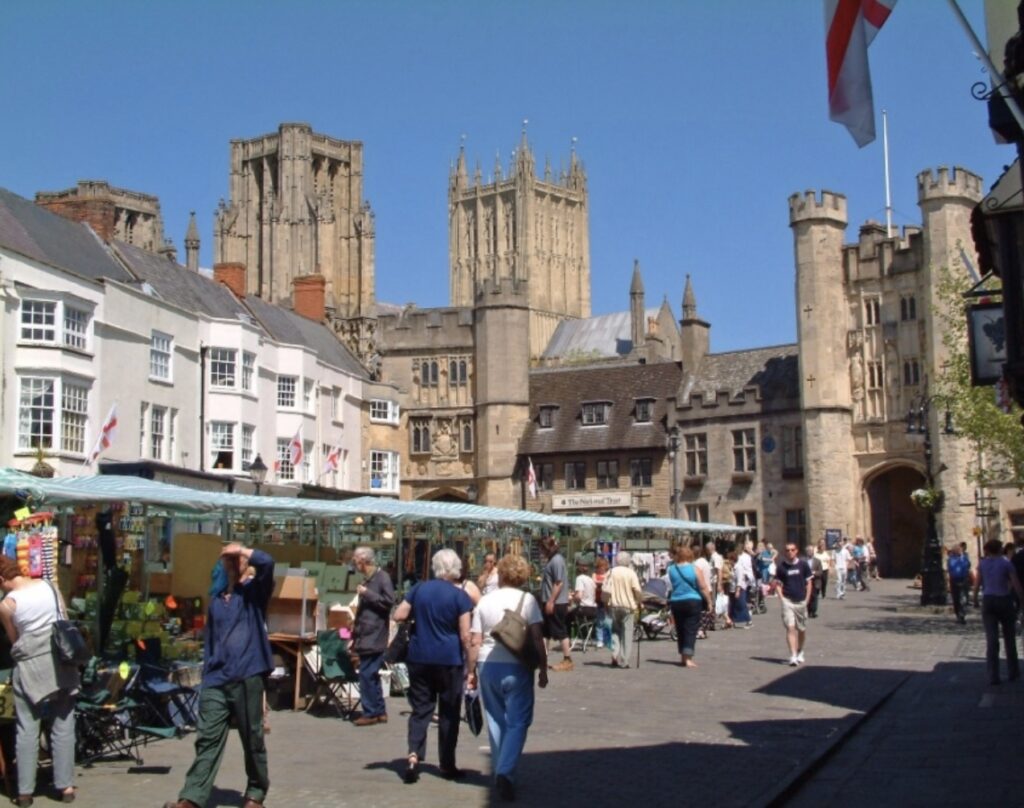
3.St. Cuthbert’s Church
- Description: Often overshadowed by the cathedral, St. Cuthbert’s Church is the largest parish church in Wells. It features a Perpendicular Gothic tower and a striking 15th-century carved roof.
- Highlights: The tower, carved roof, and historic churchyard.
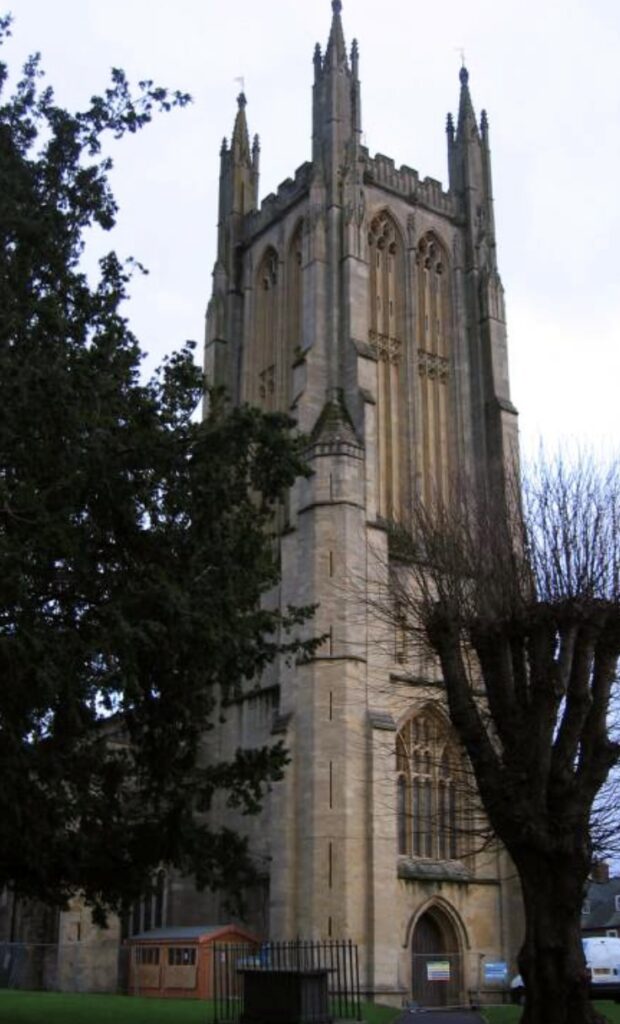
6. Wells and Mendip Museum
- Description: Located next to the cathedral, this small but fascinating museum offers insights into the history of Wells and the surrounding Mendip Hills. Exhibits cover local archaeology, geology, and the history of the cathedral.
- Highlights: Archaeological finds, geological exhibits, and local history displays.
7. The Bishop’s Barn and Recreation Ground
- Description: The Bishop’s Barn, also known as The Great Barn, is a large medieval tithe barn located within a public recreation area. It is a reminder of the agricultural heritage of the region.
- Highlights: The Great Barn, parkland, and children’s play areas.
8. The Wells & Mendip Railway
- Description: This heritage railway attraction offers visitors a chance to explore the history of rail transport in the region. Though small, it provides a nostalgic experience of steam train travel.
- Highlights: Vintage trains, railway memorabilia, and short train rides.
9. The Swan Hotel
- Description: A historic coaching inn dating back to the 15th century, The Swan Hotel is located near the cathedral. It’s a place of interest for its history and as a spot to enjoy the view of the cathedral from its terrace.
- Highlights: Historical architecture, connection to literary and cultural history, and dining with a view.
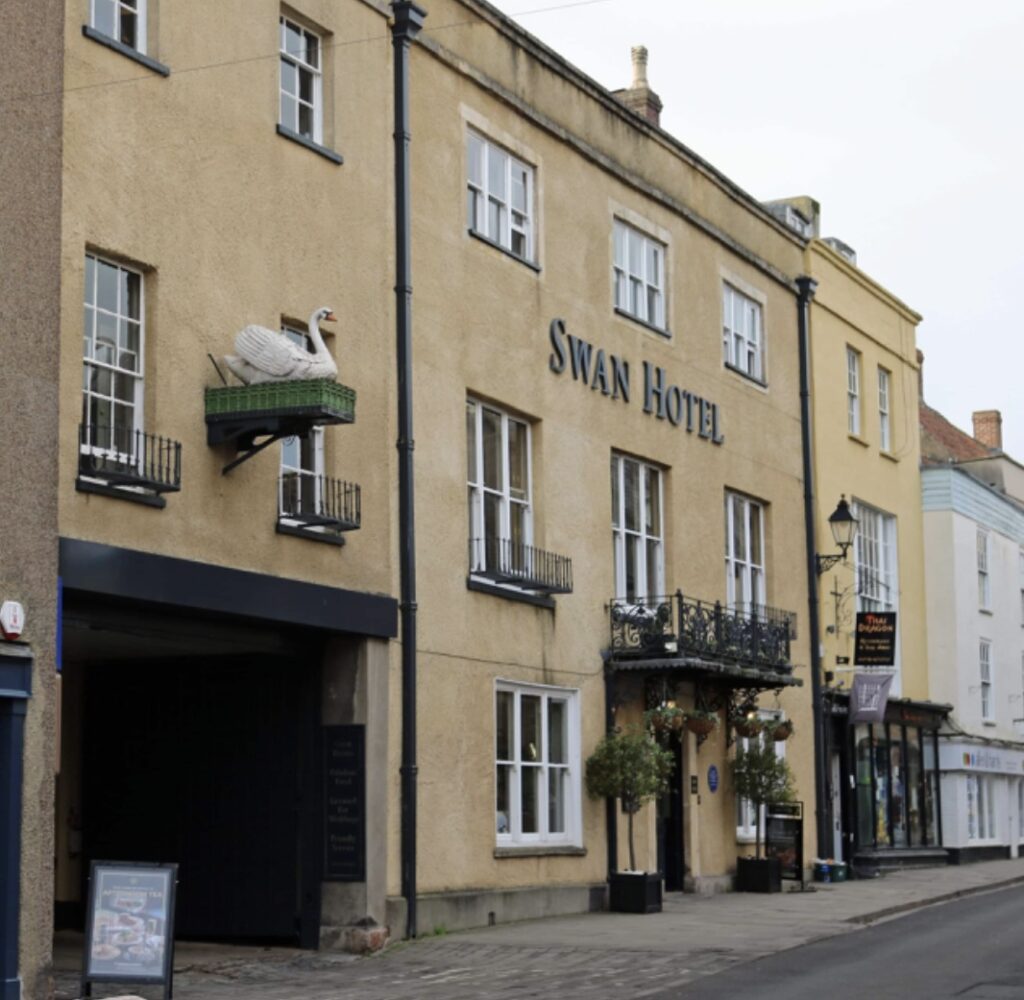
10. The Mendip Hills
- Description: The Mendip Hills, an Area of Outstanding Natural Beauty (AONB), surround Wells and offer numerous opportunities for walking, caving, and exploring the countryside.
- Highlights: Wookey Hole Caves, Cheddar Gorge, and scenic walking trails.
11. Wookey Hole Caves (near Wells)
- Description: Just outside Wells, this popular attraction offers a series of limestone caves, a paper mill, and various family-friendly activities. The caves have a rich history and are linked with legends of the Wookey Hole Witch.
- Highlights: Limestone caves, the Witch’s Kitchen, and the Wookey Hole Paper Mill.
These monuments and attractions make Wells a compelling destination, offering a mix of religious history, medieval architecture, and scenic natural beauty.
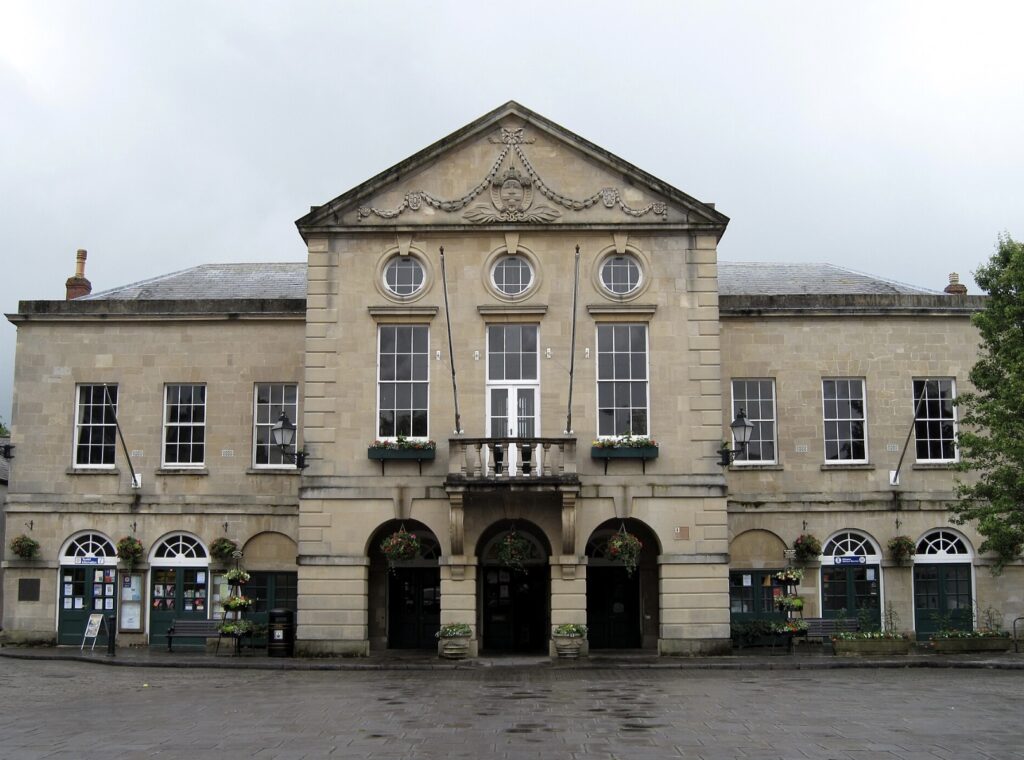
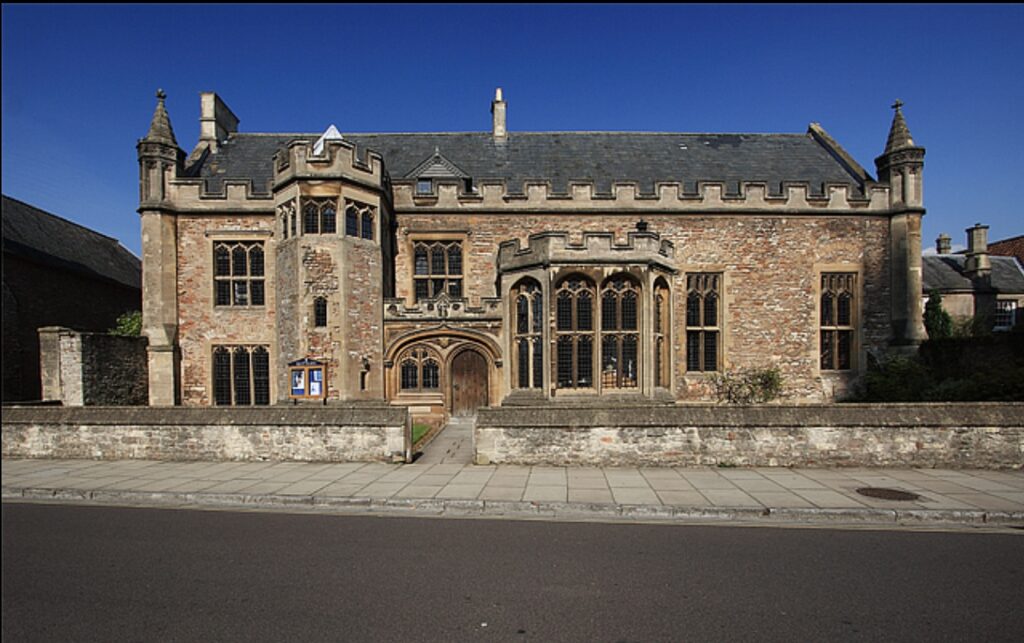
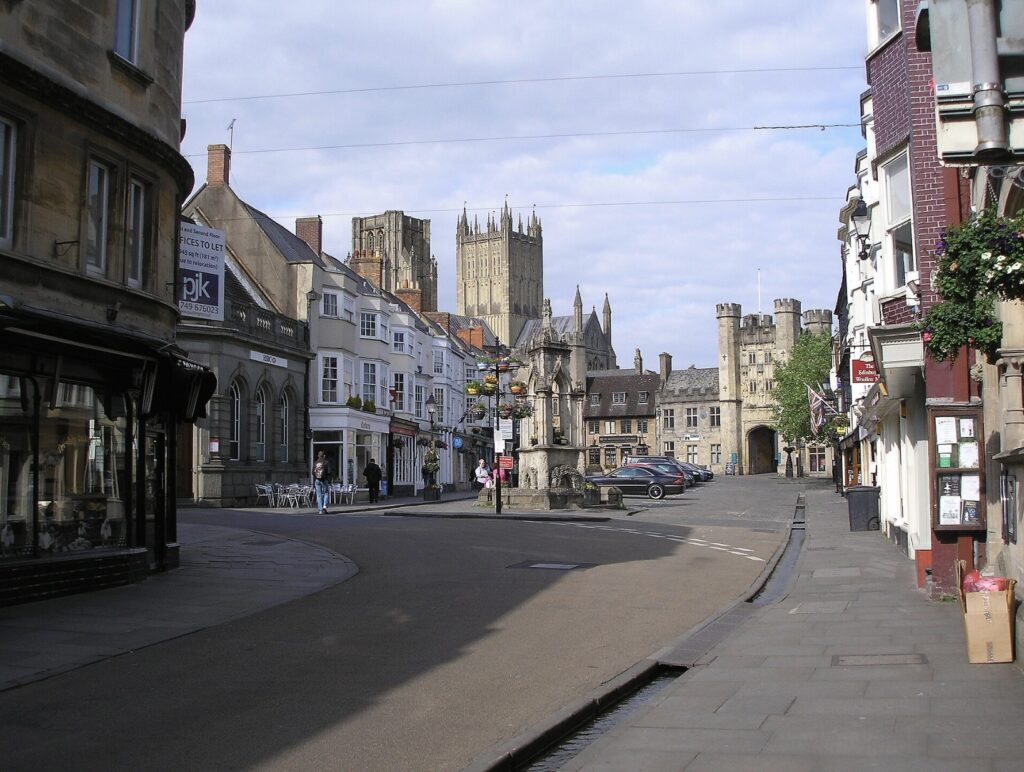
Here’s a suggested one-day itinerary for visiting Wells, incorporating the local food scene:
Morning
8:30 AM – Breakfast at The Courtyard Café
- Location: Near the Cathedral Green.
- What to Expect: Start your day with a traditional English breakfast or a lighter option like freshly baked pastries and coffee in this charming café with a view of the cathedral.
9:30 AM – Visit Wells Cathedral
- Highlights: Begin your exploration at Wells Cathedral, taking time to admire the stunning West Front, the unique scissor arches, and the beautiful stained glass. Don’t miss the Chapter House and the medieval clock.
- Tip: If possible, time your visit to hear the cathedral’s choir during a morning service for a truly atmospheric experience.
11:00 AM – Explore the Bishop’s Palace and Gardens
- Highlights: Walk over to the adjacent Bishop’s Palace. Explore the medieval architecture, the Bishop’s Chapel, and stroll through the gardens to see the springs that gave Wells its name.
- Tip: Take a peaceful moment by the moat to enjoy the view of the palace.
Midday
12:30 PM – Lunch at The Fountain Inn
- Location: Near the Market Place.
- What to Expect: Enjoy a hearty lunch at this historic pub. Try local specialties like Somerset cider-braised pork or fish and chips, paired with a pint of local ale or cider.
1:30 PM – Visit Vicars’ Close
- Highlights: After lunch, take a short walk to Vicars’ Close, the oldest continuously inhabited residential street in Europe. Wander along the cobbled street and admire the medieval houses.
Afternoon
2:00 PM – Explore the Market Place
- Highlights: If you’re visiting on a market day (Wednesday or Saturday), explore the bustling Wells Market. Browse stalls selling local produce, artisan crafts, and treats. Even if it’s not a market day, the square is still lively and worth exploring.
- Snack Stop: Pick up a local pastry or snack from one of the market stalls or nearby bakeries, like a traditional Somerset cheddar cheese scone.
2:45 PM – Visit St. Cuthbert’s Church
- Highlights: Head to St. Cuthbert’s Church, the largest parish church in Wells. Admire its Perpendicular Gothic architecture and the intricately carved roof.
3:30 PM – Afternoon Tea at The Swan Hotel
- Location: Opposite Wells Cathedral.
- What to Expect: Enjoy a classic English afternoon tea in the historic setting of The Swan Hotel. Choose from a selection of teas, finger sandwiches, scones with clotted cream and jam, and delicate pastries. The hotel’s terrace offers lovely views of the cathedral.
4:30 PM – Wells and Mendip Museum
- Highlights: End your day with a visit to the Wells and Mendip Museum, located next to the cathedral. Learn more about the history of Wells and the surrounding Mendip Hills, with exhibits on archaeology, geology, and local history.
Evening
5:30 PM – Dinner at Ensemble
- Location: In the city center.
- What to Expect: Conclude your day with a relaxed dinner at Ensemble, a contemporary restaurant offering dishes that highlight local ingredients. Consider trying their locally-sourced lamb or vegetarian options, paired with a glass of Somerset cider or a local wine.
7:00 PM – Evening Stroll
- Option: Take a leisurely evening stroll around the Cathedral Green or along the moat at the Bishop’s Palace, enjoying the serene atmosphere as the day winds down.
This itinerary gives you a comprehensive experience of Wells, combining its rich history, stunning architecture, and a taste of the local food scene.
